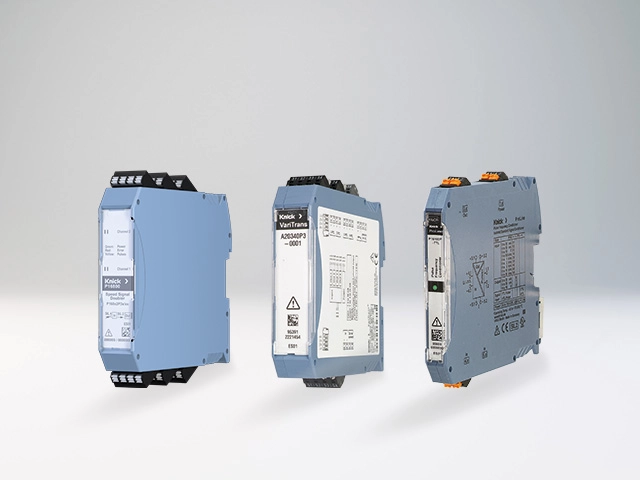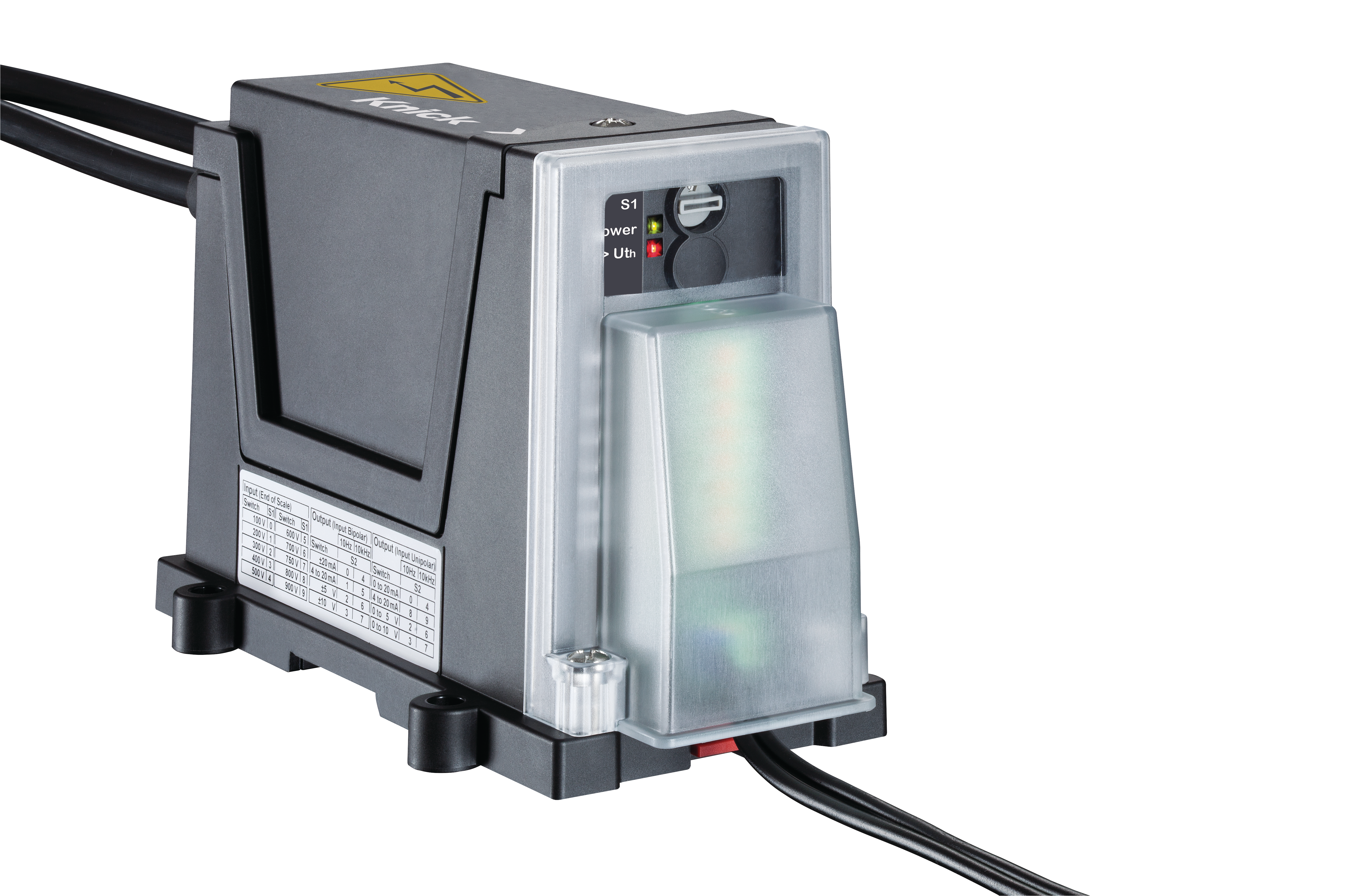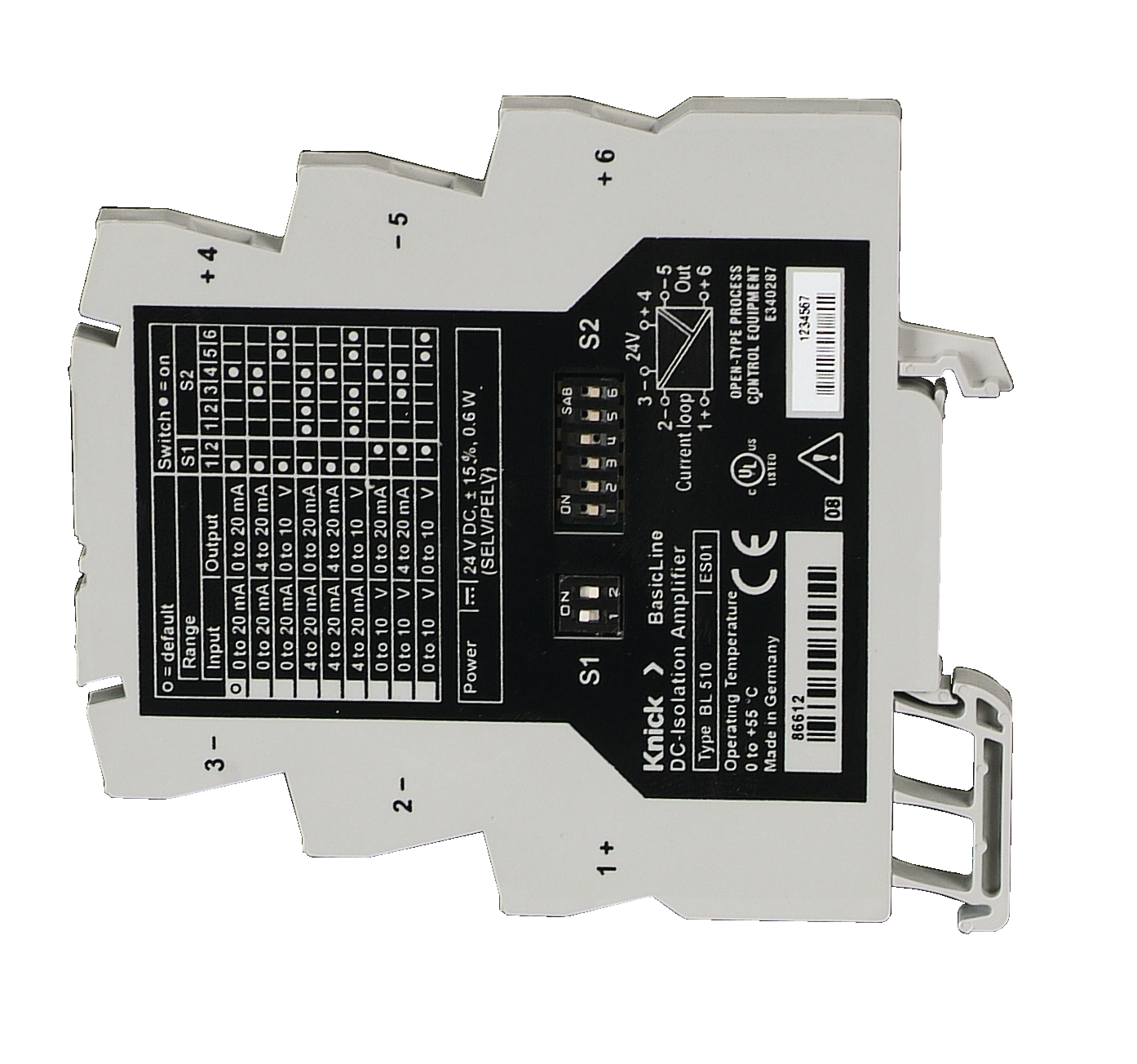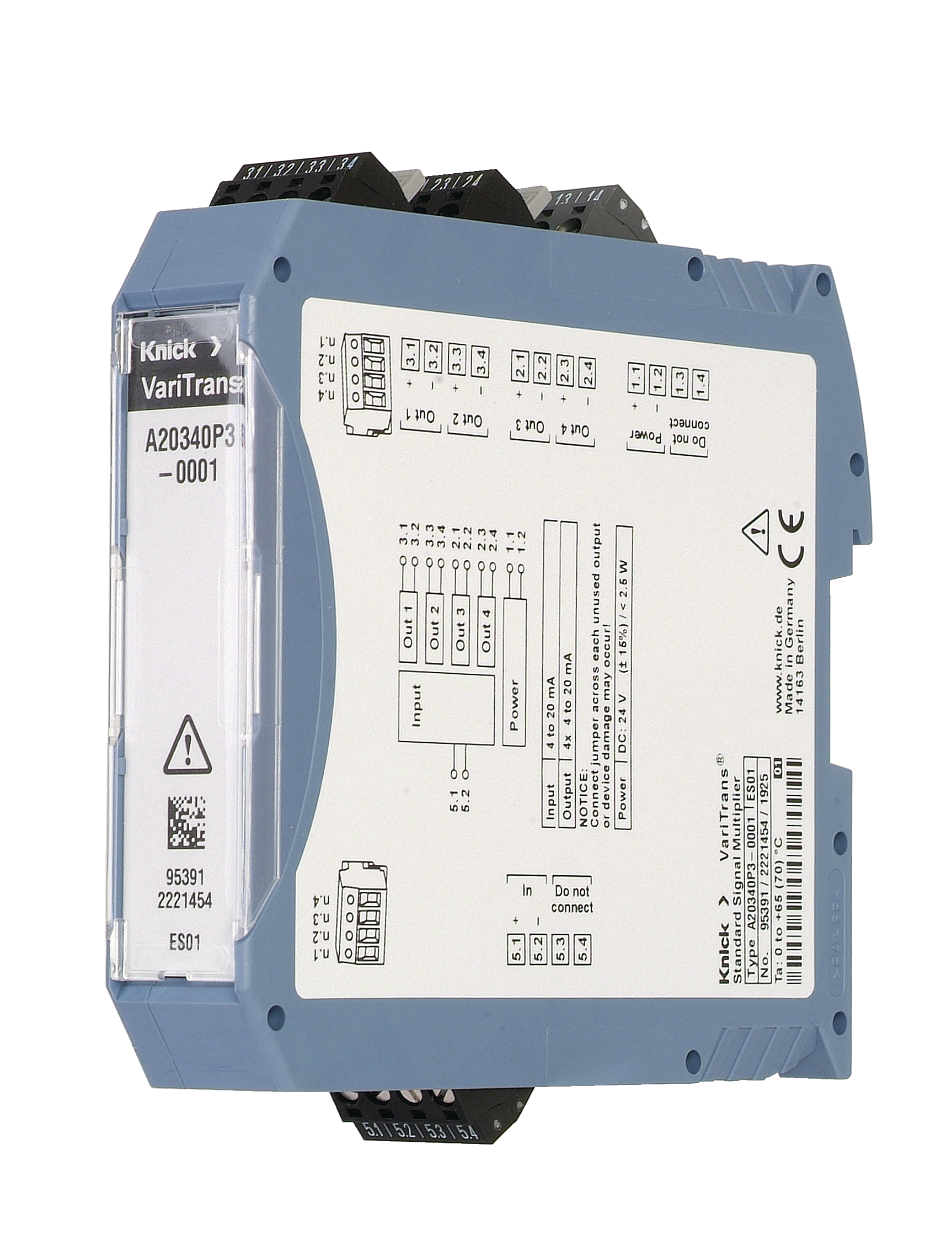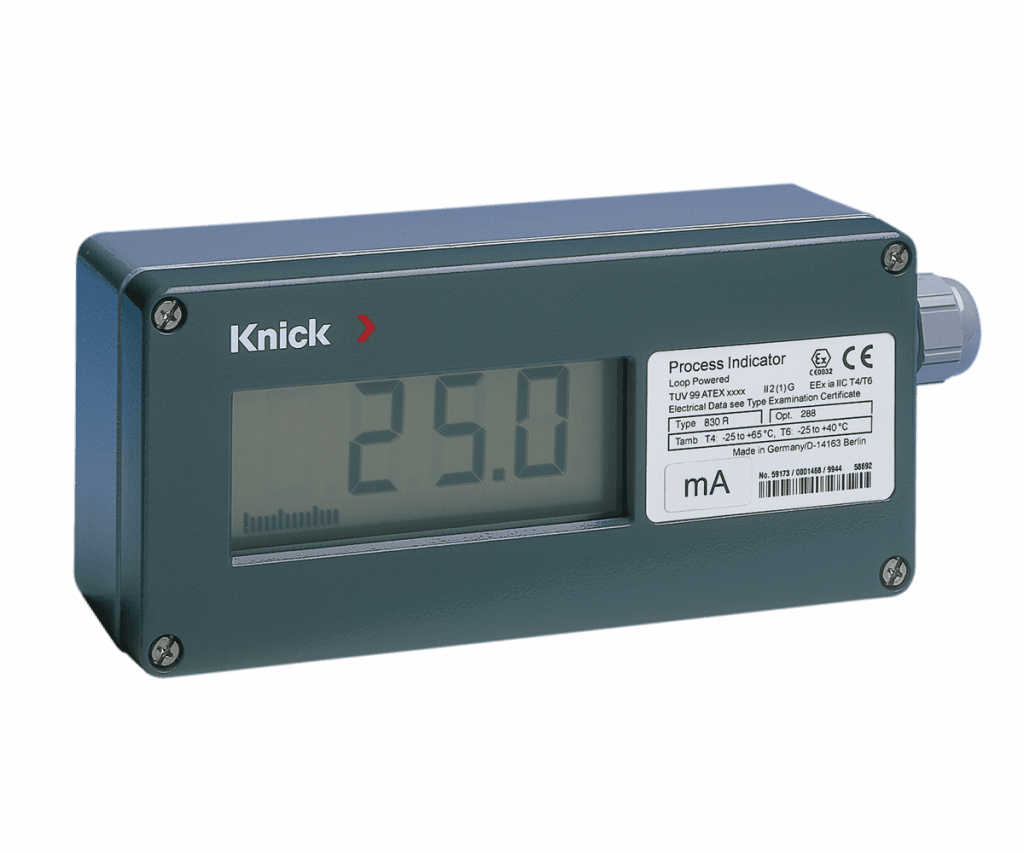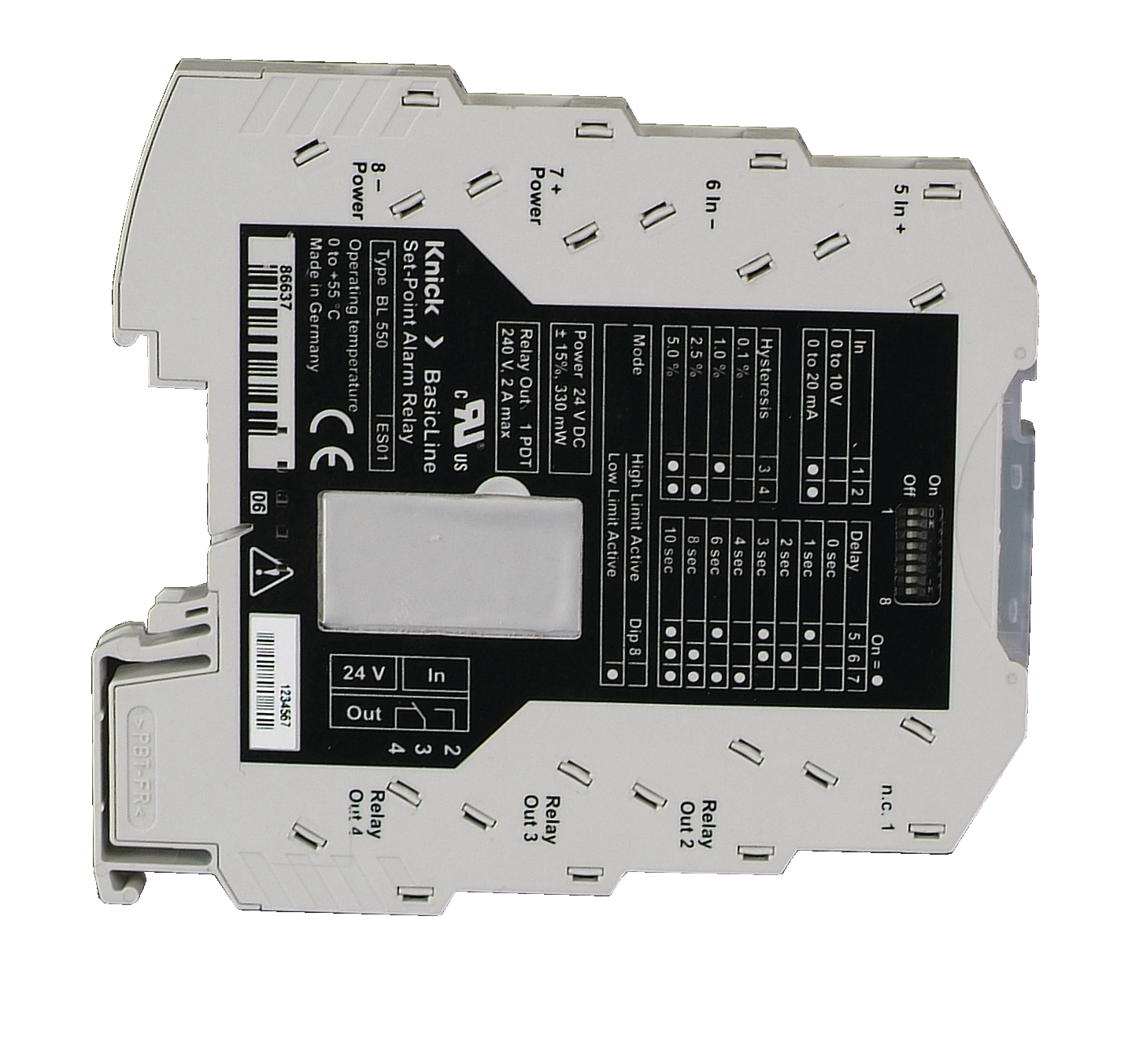High voltage transducers featuring long-term stability, transducers, and signal multipliers for advanced applications
The robust, conservatively arranged circuit design of our products guarantees stable operations over the long term with a device-dependent MTBF (mean time between failures) of up to 2,165 years. Meticulous product development, extensive design verification, and 100% routine testing ensure the high quality of our products.
International certifications such as UL, CSA, CE, DNV, SIL, KTA, and ATEX allow the device to be used globally in a variety of applications. Our signal conditioners and transducers offer crucial advantages for applications with high demands placed on insulation, signal transmission speed, and long-term stability.

From high voltage measurement to measured value display
Download the product brochure: With its comprehensive range of signal conditioners and transducers, Knick offers solutions that meet the highest standards of safety, precision, robustness and durability.
Product Highlights
Galvanic Isolation up to 6.6 kV
In industrial applications, measuring and control signals must be isolated when being transmitted – for safety reasons and in order to achieve optimal signal quality. The products used must safely master dangerously high voltage levels, a variety of groundpotentials and high common-mode voltages.
Knick's transducers and signal converters galvanically isolate the 3-ports of the input, output, and power supply from each other as standard for up to 6.6 kV of continuous isolation. The 3-port isolation reliably protects against measurement errors caused by grounding problems and interference voltage transmissions.

We look forward hearing from you!
Contact Us

Accuracy
Intelligent circuit design and integrated safety margins between the normal load and the possible maximum load in the event of an error are basic design principles employed by Knick. They also include the use of high-quality parts and eliminating components with high failure rates. Knick signal conditioners are designed not only to operate reliably under normal conditions, but also to perform their function safely under extreme operating conditions. The advantages can be found in every detail.
P29000
Input: 0 ... (±)30 mV up to 0 ... (±)100 V, 0 ... (±)100 V up to 0 ... (±)1000 V
Isolation AC/DC: up to 1,000 V
P27000
Input: 4 ... 20 mA, 0 ... (±)10 V, 0 ... (±)0.1 mA up to 0 ... (±)100 mA, 0 ... (±)20 mA, 0 ... (±)20 mV up to 0 ... (±)200 V
Isolation AC/DC: up to 1,000 V
P15000
Input: 0 ... 10 V, 4 ... 20 mA, 0 ... 20 mA
Isolation AC/DC: up to 1,000 V
P45000
Input: 0 ... (±)2000 V, 0 ... (±)1000 V, 0 ... (±)2800 V, 0 ... (±)3000 V, Overrange up to 150 %, 0 ... (±)500 V, 0 ... (±)750 V, 0 ... (±)1500 V
Isolation AC/DC: up to 3,600 V AC, 4,800 V DC
A20300
Input: 0 ... 10 V, 4 ... 20 mA, 0 ... 20 mA
Isolation AC/DC: up to 300 V
P32000
Input: Shunt voltages up to ±1000 mV, Potentiometers, Thermocouples, Resistors, Strain gauges, Resistance thermometers
Isolation AC/DC: up to 300 V
P42000
Input: 0 ... (±)100 V up to 0 ... (±)3600 V
Isolation AC/DC: 2,200 V, up to 3,600 V
A26000
Input: 0 ... (±)10 V, 0 ... (±)20 mA
Isolation AC/DC: up to 1,000 V
A20100
Input: 4 ... 20 mA
Isolation AC/DC: up to 600 V
A20340
Input: 4 ... 20 mA, 0 ... 20 mA
Isolation AC/DC: up to 300 V
BL590
Input: 0 ... (±)50 V up to 0 ... (±)500 V
Isolation AC/DC: up to 500 V
P51000
Input: 0 ... (±)30 mV up to 0 ... (±)100 V
Isolation AC/DC: up to 4,800 V
P41000
Input: 0 ... (±)50 mV up to 0 ... (±)100 V
Isolation AC/DC: up to 3,600 V
A21000
Input: 0 ... 10 V, 4 ... 20 mA, 0 ... 20 mA
Isolation AC/DC: up to 300 V
P32200
Input: Load cells, Strain gauges
Isolation AC/DC: up to 300 V
A20220
Isolation AC/DC: up to 300 V
A20210
Input: Shunt voltages up to ±1000 mV, Thermocouples, Resistors, Resistance thermometers
Isolation AC/DC: up to 300 V
P41000TRMS
Input: 0 ... 10 V AC, 0 ... 50 mV AC
Isolation AC/DC: up to 3,600 V
BL591
Input: 0 ... (±)30 mV up to 0 ... (±)1000 mV
Isolation AC/DC: up to 500 V
P42000TRMS
Input: 0 ... 3600 V AC, 0 ... 10 V AC
Isolation AC/DC: 2,200 V, up to 3,600 V
maconic
Input: 0 ... 1 A up to 0 ... 20 kA
P32100
Input: Shunt voltages up to ±1000 mV, Thermocouples, Resistors, Resistance thermometers
Isolation AC/DC: up to 300 V
P16000
Input: Speed sensor signal, 0 ... 0.5 kHz, 0 ... 1 kHz, 0 ... 2 kHz, 0 ... 5 kHz, 0 ... 10 kHz, 0 ... 20 kHz
Isolation AC/DC: up to 300 V
A20400
Input: 4 ... 20 mA, 0 ... 20 mA
Isolation AC/DC: up to 600 V
P41000AG
Input: 0 ... (±)30/330 mV up to 0 ... (±)120/1320 mV
Isolation AC/DC: up to 3,600 V
WG21
Input: 4 ... 20 mA
P52000
Input: 0 ... (±)100 V up to 0 ... (±)4800 V
Isolation AC/DC: up to 4,800 V
P16800
Input: Speed sensor signals 10 ... 33.6 V DC (max. 35 V) with Low: < 30 %, High: > 70 %, Speed sensor signals 6/7 ... 14/20 mA (max. 200 mA) with Low: < 8.5 mA, High: > 12.5 mA
Isolation AC/DC: up to 1,000 V
P32300
Input: Potentiometers, Resistors
Isolation AC/DC: up to 300 V
P22400
Input: 4 ... 20 mA, 0 ... 20 mA
Isolation AC/DC: up to 600 V
P43000TRMS
Input: 0 ... 5 A AC, 0 ... 100 mA AC
Isolation AC/DC: up to 3,600 V
P52000VPD
Input: 50 V ... 4200 V, 0 ... (±)100 V up to 0 ... (±)4800 V, max. 4800 V DC or AC peak
Isolation AC/DC: up to 4,800 V
WG25
Input: 4 ... 20 mA
Isolation AC/DC: up to 1,000 V
P43000
Input: 0 ... (±)0.1 A upt to 0 ... (±)5 A
Isolation AC/DC: up to 3,600 V
A20230
Input: Potentiometers, Resistors
Isolation AC/DC: up to 300 V
P44000
Input: 0 ... 100 °C, 0 ... 300 °C, 0 ... 200 °C
Isolation AC/DC: up to 2,000 V, up to 6,600 V






